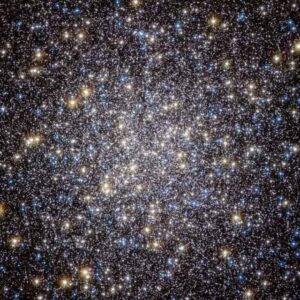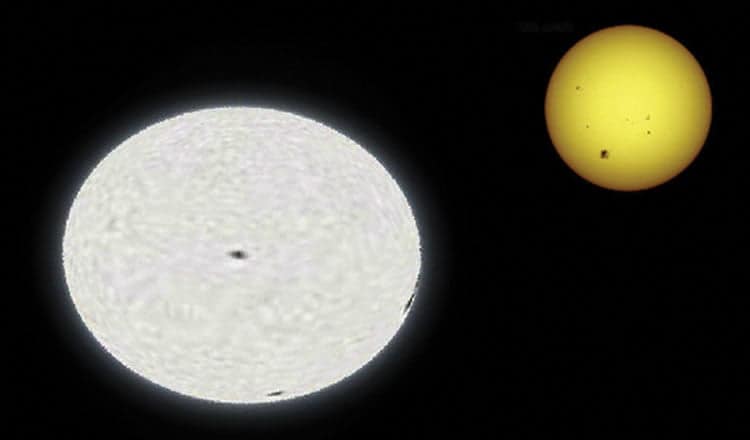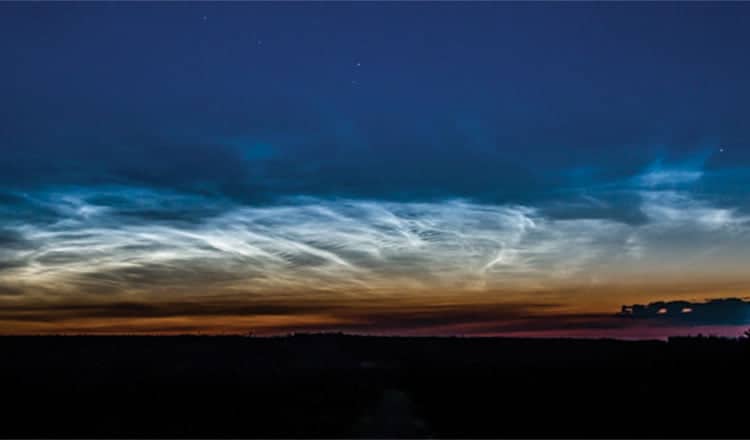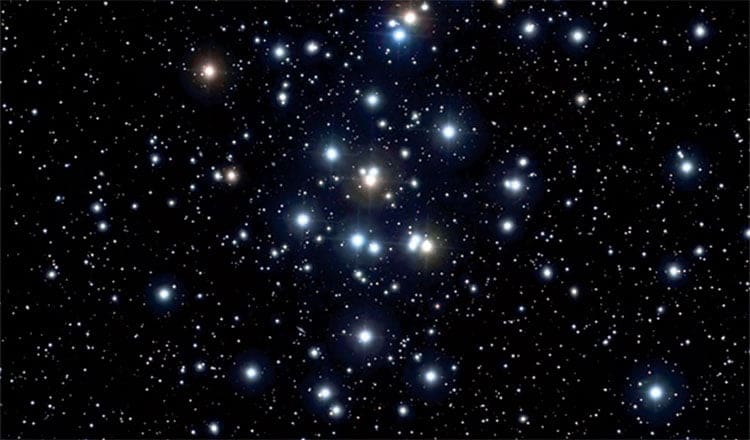A good starting point in your search for M13 is probably the star Vega. PHOTOS: freestarcharts.com

Messier 13 (M13), the best and brightest globular cluster gracing our northern sky, resides in the Hercules constellation and is a most-intriguing class of star cluster, so very different from all the open star clusters of our Milky Way galaxy. So with Hercules setting lower in the northwestern sky, every night, we’d better catch a good look at this unique class of star cluster while we still can.
The vast gas and dust clouds of the spiral arms of our galaxy are the birthing grounds of open star clusters. Denser areas of these clouds gravitationally collapse in upon themselves, eventually “turning on” hot new stars, which then blast the remains of their cocooning gas and dust away. These star clusters, as permanent as they may seem in our night sky, do not live forever. The largest stars of the clusters devour their nuclear fuel furiously and supernova out in a blaze of glory in just a few million years, while most of the rest of the stars eventually disperse through gravitational interactions with other stars. Almost all the stars we see in our night sky were born in open clusters.
Globular clusters are very different. All globulars, each a huge spherical concentration of hundreds of thousands of stars and averaging 100–200 ly in diameter, are not within the disk of our galaxy at all. They are, instead, distributed in a vast halo encircling the center of our galaxy.
But the key difference with globulars is that they are made up of uniformly aged, very old stars, upwards of 12 and 13 billion years old. That is almost as old as the Universe itself! Globular clusters formed at the same time as galaxies, perhaps a billion years after the big bang. They weren’t big enough to become galaxies, but had enough stars to gravitationally hold themselves together over time and, in turn, were held in orbits around the galactic hubs.
The more massive stars within these clusters settle into a dense core teeming with stars. Our nearest star is 4.2 ly away. In a volume of space, with that distance as a radius around our Sun, there are just two star—our Sun and Alpha Centauri. Within the same volume of space in the center of M13 are at least 10,000 stars, most of which are much more luminous than any star of our night sky. If our planet existed in the core of M13, our sky would be dazzling, but I doubt we would know what a dark sky is.
There is very little gas and dust in these clusters for the creation of new stars. It is all locked up in the stars themselves. So, because these clusters are very old, with almost no gas and dust for the creation of new stars, any massive stars that formed during the creation of the globular clusters, themselves, so long ago, have long since expired. Only a neutron star or black hole from their supernova remains as evidence of their brief but furious lives from the early epoch of globular clusters.
However, astronomers discovered a quirky star that belied this conclusion from the observed evidence—that new stars cannot exist in globular clusters because of the lack of material for their creation. With refined observing equipment (such as Hubble), astronomers discovered within the dense cores of globulars, large blue (hot) stars that had all the earmarks of newly formed stars. Without any gas and dust for their creation, it was a mystery as to where these new stars could have come from. These hot blue stars (that should have long since expired) were hanging around far too long, earning themselves the felicitous moniker “blue stragglers.”
A closer analysis of the cores of globulars, where blue stragglers reside, showed that, with the extraordinary density of stars in the core, stellar collisions actually do happen—averaging once every 10,000 years (the conclusion of one study). That is all but unheard of throughout the disk of our galaxy. There is simply too much space between the stars for that to happen.
And when two of these old stars do catastrophically collide, their cores spiral in, ever faster, and eventually merge. Their hydrogen atmospheres, which had been too far from the core and unavailable for fusion, are now so thoroughly mixed and begin spiraling down into the much more massive single core. And with this new fuel supply pouring in, fusion ramps up tremendously. So, by merging, these two ancient stars have been given a second shot at life and now blaze forth with youthful vigour as a brand-new, very-hot blue straggler.
Unfortunately, all the ancient stars of globulars, along with the fascinating intricacies of their cores, will remain unseen for you. Globulars clusters, by the nature of their distribution in a halo outside of our galaxy, are just too far away. M13, for example, is 25,000 ly away. That’s half the radius of our galaxy. So, colossal behemoths that they may be, they will always appear, even in the best binoculars, as a smudge of light. It takes a pretty good telescope to begin resolving individual stars within globulars.
Having said that, don’t be discouraged from searching M13 out, for that faint smudge of light is visible to the unaided eye. Just choose your night carefully, for it takes a clear, moonless sky for that. And do have your binoculars on hand if you wish to guarantee a visual confirmation of M13.
A good starting point in your search for M13 is probably the star Vega, unmistakable and brighter than any other in the southwest sky. It will help to print off this month’s sky chart from skymaps.com if you’re having trouble locating Vega. Once you have Vega, refer to the chart here and notice Vega just appearing on the left edge. Now star-hop over from Vega to theta, in Hercules. Four fingers viewed at arm’s length, with one eye will approximately cover that distance. Continue star-hopping to the keystone of Hercules, and just a third of the way down the right side, you will find the gem of Hercules.
And when you find that little smudge of light, as feeble as it may appear, know that those tired photons have been travelling through space at 300,000 km/sec, for the last 25,000 years, and represent the combined efforts of hundreds of thousands of ancient stars that have been continuously pumping out photons non-stop for the last 13 billion years! The grandest display of consistency ever, I would think.
The Messier Catalogue
The designation of M13 for the Hercules globular comes from the Messier Catalogue of deep sky objects. In the late 1700s, Charles Messier, a renowned comet hunter, grew frustrated with wasting his precious observing time watching fuzzy objects in the sky that would eventually prove to be something other than comets. So, although he had no idea what they were, he compiled a catalogue of all of these “fuzzies.” That way, he and his comet-hunting buddies (it seemed to be a thing in those times) could use their observing time more efficiently in their cometary pursuit. However, what Mr. Messier unwittingly compiled was a catalogue of the most-fascinating and easily observed deep sky objects for all of us modern-day stargazers—open clusters, globular clusters, galaxies and nebula. The Messier Catalogue describes 110 of these objects, and is, today, integral to astronomy, and ubiquitous among stargazers everywhere.




